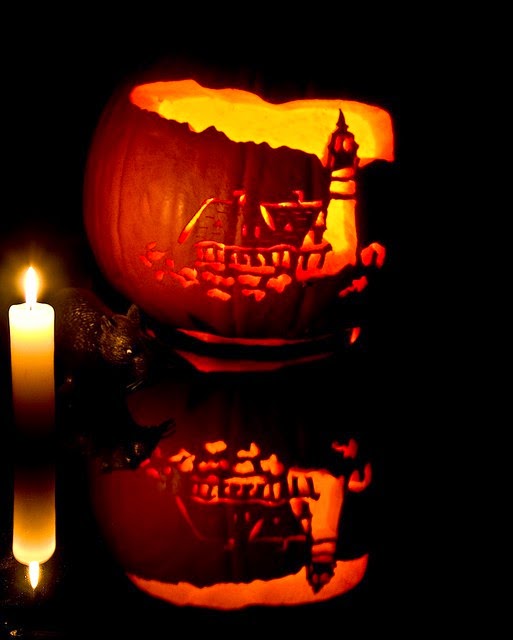At the end of this blog are pictures of some awesome lighthouse Jack-o-Lanterns, but first let's find out the origin of this fun tradition. I'll quote from an article I wrote for Weatherwise Magazine last year for Halloween. The article was about the will-o-wisp and the old ghost lights in Great Britain that gave rise to our current Jack-o-Lantern craze. Those ghost lights were really glowing swamp gases from peat bogs and other wetlands, but as you can imagine, people thought otherwise in the old days before science could explain these phenomena:
There’s
plenty of science today to explain ghost lights, but long before reason and
logical inquiry provided sensible explanations, a multitude of imaginary
characters were believed to carry these luminous specters through the wetlands
of England , Scotland , Ireland ,
and Wales
Stingy Jack is said to have been a
farmer who cheated the Devil. One night Jack robbed his neighbors and then
began running through a marsh to elude his pursuers. Suddenly, the Devil rose
up in front of Jack and threatened to take his soul for the wicked deed he had
done to his kinsman. Quick-thinking Jack fingered the crucifix he carried in
his pocket and came up with a plan. He told the Devil he could produce many
souls to take to hell if the Devil would pose as a coin in his pocket.
“I’ll toss the coin to the villagers as payment for the things I stole, and they’ll greedily argue over who gets it. You can take their wicked souls for fighting.”
The Devil liked the idea and turned himself into a coin. Jack picked up the coin and slid it into his pocket. The duped Devil landed next to the crucifix and was stripped of all his power. Stingy Jack then struck a deal by promising to let the Devil go only if he swore never to take Jack’s soul. Thus, when Jack died years later he could not enter heaven, for he had been a thief and cheat all his life, nor could he go to hell, because the Devil would not take his soul. Jack’s unwanted spirit was forced to roam the earth in darkness. The Devil, perhaps taking a pity on Jack, gave him a small bit of fire from hell. Jack carved out a large turnip and placed the fire inside. When villagers saw the eerie light of Jack’s turnip lantern, they knew he was restless and wandering.
Eventually the Jack-o-Lantern became part of Samhain, a Gaelic festival to celebrate the end of the autumn harvest. The date chosen was the night of October 31- November 1, the halfway point on the calendar between the autumnal equinox and the winter solstice. In the rapidly waning daylight, bonfires were lit to ward off the darkness and the dead, who came back at this time to walk among the living. The ghost lights seen in the marshes and bogs and graveyards on chilly autumn nights were manifestations of departed friends and family members, as well as the ill-fated Jack-o-Lantern.
Beckett Gladney posted this one on Flicker.
Here's one from Norbini on Flicker.
Purdueila on Flicker, of Cape Hatteras Lighthouse.
Steve on Flicker did several designs, including Portland Head Lighthouse.
www.nauticalcottage.com has several, including this one.
Get out those carving tools, do a little sketching on a fat pumpkin. Carve your favorite lighthouse or a generic one. As seasoned pumpkin carvers know, you can carve straight through to the inside of the pumpkin, or you can cut away layers to create a relief that glows. To reduce the risk of fire from a candle, use a battery-powered candle or a glow stick. There's no right way or wrong way, though, just a fun way!
In October, all lighthouses become tall Jack-o-Lanterns!












No comments:
Post a Comment
I welcome your comments, photos, stories, etc.!